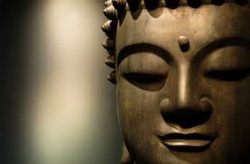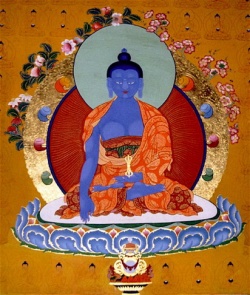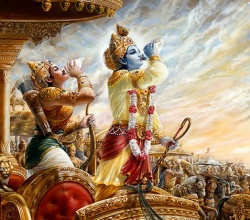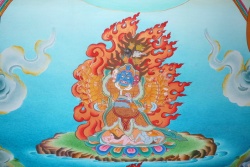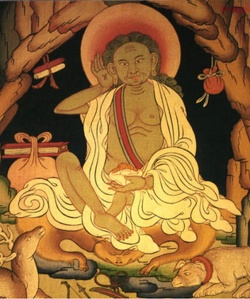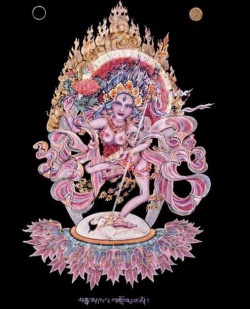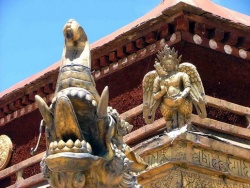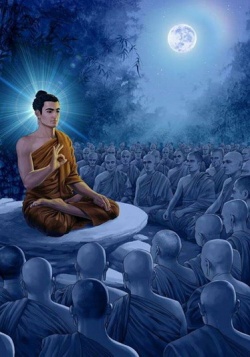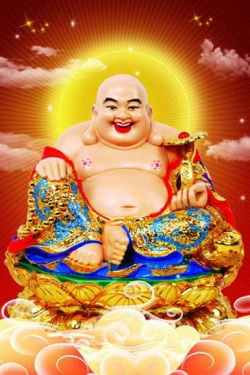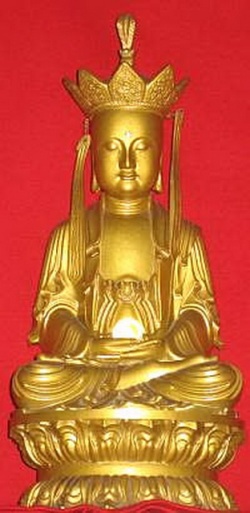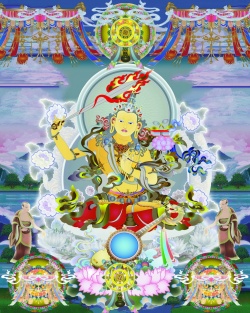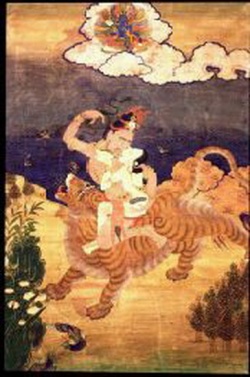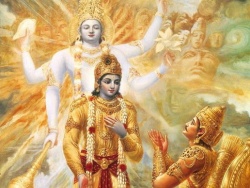Difference between revisions of "The Buddha Speaks of Amitabha Buddha Sutra Part 1"
| (12 intermediate revisions by 2 users not shown) | |||
| Line 1: | Line 1: | ||
{{DisplayImages|1424|1253|1433|1348|1124|447|1995|395|604|1062|198|1331|1723|801|65}} | {{DisplayImages|1424|1253|1433|1348|1124|447|1995|395|604|1062|198|1331|1723|801|65}} | ||
| − | + | ||
| + | |||
| + | |||
| + | |||
| + | |||
| + | |||
The [[Buddha Speaks of Amitabha Sutra]] | The [[Buddha Speaks of Amitabha Sutra]] | ||
| + | |||
Translated into {{Wiki|Chinese}} by: | Translated into {{Wiki|Chinese}} by: | ||
| − | [[Tripitaka]] [[Dharma Master]] [[Kumarajiva]] | + | |
| − | during the Yao | + | [[Tripitaka]] [[Dharma]] [[Master]] [[Kumarajiva]] |
| + | |||
| + | during the [[Yao Qin Dynasty]] | ||
| + | |||
Based on the English Translation by: | Based on the English Translation by: | ||
| + | |||
[[Buddhist Text]] Translation {{Wiki|Society}} | [[Buddhist Text]] Translation {{Wiki|Society}} | ||
| + | |||
A General Explanation by: | A General Explanation by: | ||
| − | [[Master]] | + | |
| + | [[Master]] Yong Hua | ||
| + | |||
Lu Mountain [[Temple]] | Lu Mountain [[Temple]] | ||
| − | The [[Buddha | + | INTRODUCTION |
| + | |||
| + | Five Major Schools of {{Wiki|Asian}} [[Buddhism]] | ||
| + | |||
| + | The [[Buddha Speaks of Amitabha Buddha Sutra]] is generally known as the (Small) [[Small Amitabha Sutra]]. | ||
| + | |||
| + | |||
| + | It is one of the most important [[sutras]] of [[Pure Land Buddhism]], which is one of the five major schools of {{Wiki|Asian}} [[Buddhism]]: | ||
| + | |||
1. The [[Vinaya School]]. | 1. The [[Vinaya School]]. | ||
| − | 2. The [[Chan]] | + | 2. The [[Chan School]]. |
| − | 3. The Secret School. | + | 3. [[The Secret School]]. |
| − | 4. The Teachings School. | + | 4. The [[Teachings School]]. |
5. The [[Pure Land School]]. | 5. The [[Pure Land School]]. | ||
| − | |||
| − | 1. No Killing, including ants, let alone [[hunting]] for sport. | + | The [[Vinaya School]] emphasizes the study and practice of [[morality]]. [[Buddhist]] lay [[disciples]] should [[take refuge]] with the [[Triple Jewel]] and then they can receive the [[Five Precepts]], the [[Eight Precepts]] or the [[Bodhisattva Precepts]]. |
| − | 2. No [[Stealing]], including buying pirated goods. | + | |
| + | The foundation of lay [[morality]] is based on the [[Five Precepts]]: | ||
| + | |||
| + | |||
| + | 1. No {{Wiki|Killing}}, [[including]] ants, let alone [[hunting]] for sport. | ||
| + | 2. No [[Stealing]], [[including]] buying pirated goods. | ||
3. No {{Wiki|Sexual}} Misconduct: This means no {{Wiki|sex}} outside of [[marriage]]. | 3. No {{Wiki|Sexual}} Misconduct: This means no {{Wiki|sex}} outside of [[marriage]]. | ||
| − | 4. No False [[Speech]], including words intended to [[cause]] discord. | + | 4. No False [[Speech]], [[including]] words intended to [[cause]] discord. |
| − | 5. No Taking of [[Intoxicants]], including [[alcohol]], cigarettes, [[drugs]] etc. | + | 5. No Taking of [[Intoxicants]], [[including]] [[alcohol]], cigarettes, [[drugs]] etc. |
| + | |||
| + | |||
| + | Left-home [[people]] can take the [[Ten Precepts]] of [[novice]] [[monks and nuns]], [[Siksamana Precepts]], [[Bhikshu Precepts]], [[Bhikshuni Precepts]] or [[Bodhisattva Precepts]]. | ||
| + | |||
| + | Observing the [[precepts]] will bring [[forth samadhi]], which is [[Sanskrit]] for [[concentration]]. | ||
| − | + | [[Samadhi]] unfolds [[Wisdom]] and thus can help certify to the [[fruitions]]. | |
| − | The [[Chan]] | + | This is the typical approach of the [[Small Vehicle]], also known as [[Hinayana]], that is very popular in countries like [[Sri Lanka]], {{Wiki|Myanmar}}, [[Cambodia]], {{Wiki|Western}} {{Wiki|Europe}}, etc. |
| + | |||
| + | The [[Chan School]] emphasizes the [[development]] of [[samadhi]]. | ||
| + | |||
| + | One can progress through from our normal [[state]] of scatteredness to the [[Four Dhyanas]] of the [[Form Realm]], the [[Four Samadhis]] of the [[Formless Realm]], the [[Ninth Samadhi]] of the [[Arhat]], etc… all the way to the [[Tathagata’s samadhi]]. | ||
| + | |||
| + | |||
| + | [[Chan]] practitioners begin their [[cultivation]] {{Wiki|training}} with the [[Five Stoppings of the Mind]] : | ||
| + | |||
| + | |||
| + | |||
| + | == [[Five Stoppings of the Mind]] == | ||
| + | |||
| + | |||
| + | |||
| + | 1. Contemplation of the Impure : Looking at how impure the [[body]] really is, thus reducing [[greed]] and [[desire]] and stopping the mad [[mind]]. | ||
| + | |||
| + | 2. Contemplation of [[Kindness]] and [[Compassion]] : This will counteract [[anger]] and [[rage]] and thus will stop the mad [[mind]]. | ||
| − | 4. Contemplation of the [[Breath]] : Using the [[breath]] counting techniques to overcome scatteredness and thus stop the mad [[mind]]. 5. [[Mindfulness of the Buddha]] : Reciting the [[Buddha’s]] [[name]], being [[mindful]] of the [[Buddha’s]] [[merit]] and [[virtue]], thus eradicating obstructions and | + | 3. Contemplation of [[Causes]] and [[Conditions]] : Reflecting on the twelve [[conditioned]] links that explain how the [[world]] evolves, thus [[overcoming]] [[stupidity]] and stopping the mad [[mind]]. |
| + | |||
| + | 4. Contemplation of the [[Breath]] : Using the [[breath]] counting [[techniques]] to overcome scatteredness and thus stop the mad [[mind]]. | ||
| + | |||
| + | 5. [[Mindfulness of the Buddha]] : Reciting the [[Buddha’s]] [[name]], being [[mindful]] of the [[Buddha’s]] [[merit]] and [[virtue]], thus eradicating obstructions and retributions and stopping the mad [[mind]]. | ||
| + | |||
| + | You can progress along to increasingly higher levels of [[samadhis]] until you attain the [[Tathagata’s]] [[Chan]] . | ||
| + | |||
| + | When inquired by his [[Master]] about his [[views]], a [[Chan]] [[student]] re-plied, “Last year, I was so poor that my only possession was a ladle (made of {{Wiki|bamboo}} to drink [[water]] from; you can see this type of utensil in {{Wiki|Chinese}} and [[Japanese]] movies). | ||
| + | |||
| + | This year, I am so poor that I don’t even have a ladle.” | ||
| + | |||
| + | This means that last year, the pupil still was [[attached]] to one ladle. He was poor with material possessions but we need not be sympathetic to his plight. | ||
| + | |||
| + | He had to become very rich in [[spiritual]] [[blessings]] before he could get to be so destitute materially. | ||
| + | |||
| + | This year he [[detached]] from the ladle and therefore was [[enlightened]]. | ||
| + | |||
| + | That is the [[Buddha’s]] [[wisdom]] [[arising]] from the [[Tathagata’s]] [[Chan]]. | ||
| + | |||
| + | [[Chan]] is widely practiced in [[China]], [[Korea]], [[Japan]], [[Vietnam]] etc. | ||
| + | |||
| + | [[The Secret School]] utilizes the Secret True Words [[Dharma]] . | ||
| + | |||
| + | The {{Wiki|Chinese}} and [[Japanese]] have their [[own]] set of [[sutras]] as their Bible: . | ||
| + | |||
| + | They establish [[mandalas]] , and practice [[mantras]] to the level where the three secrets and three [[karmas]] are in compliance and thus accomplish their {{Wiki|purpose}}: becoming a [[Buddha]]. | ||
| + | |||
| + | While the {{Wiki|Chinese}} and [[Japanese]] also have secret sects, the [[Tibetans]] specialize in this practice. | ||
| + | |||
| + | The [[Teachings School]] puts the {{Wiki|emphasis}} on the research and [[understanding]] of [[doctrine]]. | ||
| + | |||
| + | |||
| + | |||
| + | They investigate the [[Buddhist]] cannon: the [[Tripitaka]], consisting of the [[Vinaya Store]] that contains the {{Wiki|rules}} of [[morality]] and deportment, | ||
| + | |||
| + | the [[Sutra Store]] which consists of [[sermons]] of the [[Buddha]], and | ||
| + | |||
| + | the [[Shastra Store]] that is the commentaries of the [[Buddha’s enlightened disciples]]. | ||
| + | |||
| + | |||
| + | |||
| + | [[Understanding]] the [[Buddhist teaching]] is necessary for the unfolding of our [[inherent]] [[wisdom]]. | ||
| + | |||
| + | All the other Schools must use the [[methods]] of the [[Teachings School]] to educate their fol-lowers on their School’s [[doctrines]]. | ||
| + | |||
| + | Conversely, the [[Teachings School]] must also rely on the other School’s {{Wiki|training}} [[techniques]] to develop [[samadhi]] before their [[wisdom]] can truly unfold. Finally, the [[Pure Land School]] is the most popular school in our {{Wiki|era}}, especially in {{Wiki|Asia}}. | ||
| + | |||
| + | It advocates [[rebirth]] to the [[Pure Lands]] where, unlike our [[Saha world]], the [[conditions]] are much more favorable for [[cultivation]]. | ||
| + | |||
| + | In fact, if we can make it to the [[Pure Lands]], we can accomplish [[Buddhahood]] in one [[life-time]], thus escaping the dreadful [[Wheel of Reincarnation]]. | ||
| + | |||
| + | Reciting [[Amitabha Buddha’s]] [[name]] to obtain [[rebirth]] to his [[Western Bliss Pure Land]] is widely considered to be the only [[Pure Land]] practice. | ||
| + | |||
| + | However, [[Amitabha’s]] [[Pure Land]] is just one of many [[Pure Lands]]. | ||
| + | |||
| + | |||
| + | For example, [[Medicine Master]] [[Buddha’s]] | ||
| − | + | [[Pure Land]] lies to the [[east]] as explained in our publication, The [[Medicine Master Sutra]]. | |
| − | + | In addition it is little known, even to [[Buddhists]], that [[Maitreya’s]] [[Pure Land]] is situated in the inner court of the [[Tushita Heaven]]. | |
| − | + | The [[Pure Land]] [[Dharma]] is appropriate for all [[living beings]] of the three [[faculties]]: {{Wiki|superior}}, average and {{Wiki|inferior}}. | |
| + | |||
| + | We {{Wiki|hope}} to dispel the many confusions and misunderstandings about [[Pure Land Buddhism]] as we {{Wiki|present}} our [[Pure Land Buddhism]] to the [[West]]. | ||
| − | |||
[[Traditionally]], the ancients consider the [[Pure Land teachings]] to be contained in the three [[Pure Land]] [[Sutras]] : | [[Traditionally]], the ancients consider the [[Pure Land teachings]] to be contained in the three [[Pure Land]] [[Sutras]] : | ||
| − | The [[Buddha]] Speaks of [[Amitabha Buddha | + | The [[Buddha]] Speaks of [[Amitabha Buddha Sutra]], The [[Contemplation Sutra]], and The [[Infinite Life Sutra]]. |
| + | |||
| + | |||
| + | Some others also include two additional [[sutras]]: The [[Avatamsaka]] | ||
| + | |||
| + | [[Chapter]] 40, The [[Universal Worthy]] [[Bodhisattva’s]] [[Vows]] and Practices, and the [[chapter]] in The [[Shurangama Sutra]] on [[Great Strength Bodhisattva’s Perfect Penetration]], making [[Five Pure Land Sutras]] in all . | ||
| + | |||
| + | |||
| + | Among the [[Pure Land teachings]], The [[Buddha Speaks of Amitabha Buddha Sutra]] is the most well-known. | ||
| + | |||
| + | It is also the most often recited [[sutra]]. | ||
| + | |||
| + | This is because by reciting it, it be-comes easier to understand. The {{Wiki|principles}} contained herein are quite profound and very [[hard to fathom]] thus making it very difficult to bring forth [[faith]]. | ||
| + | |||
| + | We will therefore try to both retain its depth and preserve the [[spirit]] of the teachings | ||
| + | |||
| + | while also [[offering]] elaborations in simple terms, hopefully making it more understandable to the ordinary reader. | ||
| + | |||
| + | |||
| + | Translated into {{Wiki|Chinese}} by [[Tripitaka]] [[Dharma Master]] [[Kumarajiva]] of [[Yáo Qín]]. | ||
| + | |||
| + | |||
| + | A [[Tripitaka]] [[Dharma Master]]: | ||
| − | |||
1. Takes the [[Tripitaka]] as [[teacher]]. | 1. Takes the [[Tripitaka]] as [[teacher]]. | ||
2. Explains the [[Dharma]] to [[living beings]]. | 2. Explains the [[Dharma]] to [[living beings]]. | ||
| − | There are four kinds of | + | |
| + | |||
| + | == There are [[four kinds of Dharma Masters]]: == | ||
| + | |||
| + | |||
1. Those who explain [[Dharma]] for others , through lecturing [[sutras]] and discussing the {{Wiki|principles}} of the [[Dharma]]. | 1. Those who explain [[Dharma]] for others , through lecturing [[sutras]] and discussing the {{Wiki|principles}} of the [[Dharma]]. | ||
2. Those who read and recite [[sutras]] for others . | 2. Those who read and recite [[sutras]] for others . | ||
3. Those who write out [[sutras]] for others . | 3. Those who write out [[sutras]] for others . | ||
| − | 4. Those who accept and maintain [[sutras]] themselves : They accept the [[sutra]] {{Wiki|principles}} with their [[mind]], and put its {{Wiki|principles}} into practice with their [[body]]. All the [[Buddhist sutras]] are for the sake of providing [[knowledge]] to help [[living beings]] [[awaken]] to the true {{Wiki|principles}}. Depending on their potential and particular circumstances, this is accomplished through the four Kinds of Complete Giving: | + | 4. Those who accept and maintain [[sutras]] themselves : |
| + | |||
| + | |||
| + | They accept the [[sutra]] {{Wiki|principles}} with their [[mind]], and put its {{Wiki|principles}} into practice with their [[body]]. | ||
| + | |||
| + | All the [[Buddhist sutras]] are for the [[sake]] of providing [[knowledge]] to help [[living beings]] [[awaken]] to the true {{Wiki|principles}}. Depending on their potential and particular circumstances, this is accomplished through the four Kinds of Complete Giving: | ||
| + | |||
| + | |||
| + | 1. [[Mundane]] Complete Giving : One practices giving by using [[worldly]] means. | ||
| + | |||
| + | |||
| + | This enables [[living beings]] to obtain [[bliss]] and [[benefit]]. | ||
| + | |||
| + | In particular, when hearing about the [[Pure Land]] and [[Amitabha]], [[living beings]] will give rise to [[happiness]]. | ||
| + | |||
| + | |||
| + | 2. Curative Complete Giving : By targeting specific problems one enables [[living beings]] to obtain the [[benefit]] of eradicating [[evil]]. For example, the [[Dharma]] of Contemplating the Impure can be transmitted to quell [[desires]]. | ||
| + | |||
| + | Just execute it as instruct-ed in [[thought]] after [[thought]], and you will extinguish [[evil]] [[karmas]] of [[body]], {{Wiki|mouth}} and [[mind]]. | ||
| + | |||
| + | |||
| + | 3. [[Universal]] Complete Giving : This kind of giving is done for the [[sake]] of all [[living beings]], and enables them to obtain the possibility of [[rebirth]]. | ||
| + | |||
| + | After hearing of this [[Dharma Door]], they bring forth the [[desire]] to be [[reborn]] and draw near [[Amitabha Buddha]]. | ||
| + | |||
| + | They only need to recite the [[Buddha’s]] [[name]] to obtain [[rebirth]]. [[Universal]] Complete Giving thus contributes to the [[causes]] and [[conditions]] for numerous [[good roots]], [[merits]] and [[virtues]]. | ||
| + | |||
| + | |||
| + | 4. Primary Meaning Complete Giving : This final type of giving involves sharing the [[ultimate truth]] with all [[living beings]], who therefore obtain the [[benefit]] of entering the {{Wiki|principles}}. | ||
| + | |||
| + | |||
| + | |||
| + | This [[Dharma]] calls for reciting the [[Buddha’s]] [[name]]. In [[time]], as their [[gong-fu]] deepens, they will [[awaken]] to the Primary Meaning and obtain the “[[One mind]] unconfused in [[principle]].” | ||
| + | |||
| + | The {{Wiki|Chinese}} version that is the basis of our English translation was translated from [[Sanskrit]] into {{Wiki|Chinese}} by [[Tripitaka]] [[Dharma Master]] [[Kumarajiva]] . | ||
| + | |||
| + | The {{Wiki|Chinese}} historical records have many details on his [[life]]. | ||
| + | |||
| + | [[Yáo Qín]] (344-413 A.D.) refers to the period of [[Emperor]] o Xing’s reign . | ||
| + | |||
| + | [[Dharma Master]] [[Kumarajiva’s]] father, [[Kumarayana]] , was the son of a prime [[minister]]. Instead of succeeding his father, [[Kumarayana]] left the home-life and went looking for a [[teacher]]. | ||
| − | + | He did not really receive the [[monks]]’ [[precepts]] but was a cultivator. When he reached [[Kucha]] in {{Wiki|Central Asia}}, the [[Kucha]] king’s younger sister fell in [[love]] with him and they got [[married]] by {{Wiki|royal}} decree. | |
| − | |||
| − | |||
| − | + | [[Kumarayana]] then became an official in the court of the [[king]] and his wife soon became {{Wiki|pregnant}}. | |
| − | + | As in Ven. [[Shariputra’s]] case, she defeated everyone in [[debates]], prompting an [[Arhat]] to say, | |
| − | + | “The child in this woman’s [[womb]] is certainly one of [[great wisdom]].” She gave [[birth]] to [[Kumarajiva]]. Ven. [[Kumarajiva]] has outstanding [[memory]]. | |
| − | + | In one day he could memorize more than 36,000 words . | |
| − | + | In two days he was able recite the entire [[Dharma Blossom Sutra]] from [[memory]]. | |
| − | [[Emperor]] Yáo Cháng reigned for several years before his nephew Yáo [[Xing]] took over. The [[Emperor]] | + | At the age of seven, he followed his mother to a [[temple]] and lifted a large steel [[incense]] [[urn]] over his head effortlessly… [[Doubt]] arose: he [[thought]], |
| − | The | + | |
| + | “I’m only a child, how can I lift this heavy [[urn]]” and he immediately had to drop the [[urn]] prompting him to realize that “the ten thousand things are made from the [[mind]] alone.” | ||
| + | |||
| + | He and his mother decided to leave the home-life. | ||
| + | |||
| + | His father refused, so his mother went on a hunger fast. | ||
| + | |||
| + | After six days, she nearly [[died]] and forced her husband to give in. | ||
| + | |||
| + | She asked for her [[hair]] to be cut (which actually enabled her to certify to First Stage [[Arhatship]]) before she would eat again. | ||
| + | |||
| + | Soon, they both left the home-life. | ||
| + | |||
| + | [[Kumarajiva]] began to study the [[sutras]]. | ||
| + | |||
| + | He had {{Wiki|photographic memory}}. | ||
| + | |||
| + | He first studied [[Hinayana]] in {{Wiki|Kasmir}} under his [[teacher]] until the age of twelve. | ||
| + | |||
| + | Then his mother took him back to [[Kucha]]. | ||
| + | |||
| + | On the way, an [[Arhat]] took a look and told his mother that if this boy managed not to break [[precepts]] by the age of 35, he would save countless [[living beings]]. | ||
| + | |||
| + | |||
| + | He began to study the [[Mahayana teachings]] under [[Dharma Master]] [[ryasoma]] and truly ex-celled. | ||
| + | |||
| + | He then went back to {{Wiki|Kasmir}} to visit his previous [[Hinayana]] [[teacher]], for whom he expounded the [[Mahayana teachings]]. | ||
| + | |||
| + | His original [[teacher]] was eventually convinced and also converted to [[Mahayana]]. | ||
| + | |||
| + | His [[Hinayana]] [[teacher]] asked to [[bow]] to Ven. [[Kumarajiva]] as his [[teacher]]. | ||
| + | |||
| + | [[Great Master]] [[Kumarajiva]] dared not accept. | ||
| + | |||
| + | His ex-teacher said, “I am a [[Hinayana monk]]. | ||
| + | |||
| + | |||
| + | What’s improper about me [[bowing]] to a [[Mahayana monk]]” Ven. [[Kumarajiva]] thus accepted. | ||
| + | |||
| + | He then returned to [[Kucha]], his [[own]] country. | ||
| + | |||
| + | His mother foresaw that the for-tunes of the country were declining. | ||
| + | |||
| + | She therefore decided to go to [[Tibet]] where she certified to Third Stage [[Arhatship]]. | ||
| + | |||
| + | Be-fore leaving, she advised her son to go to [[China]] to spread [[Mahayana]] and forsake his [[life]] to serve [[Buddhism]] and [[benefit]] [[living beings]]. | ||
| + | |||
| + | [[Kumarajiva]] defeated all [[non-Buddhist]] [[philosophers]] in [[India]] and became very well known. | ||
| + | |||
| + | His reputation spread to [[China]]. | ||
| + | |||
| + | The {{Wiki|Chinese}} [[Emperor]] [[Fú Jian]] was advised by his [[astrologer]] of a most [[auspicious]] stellar [[manifestation]] in [[India]] indicating that a great [[virtuous]] and [[wise]] man would come to [[China]]. | ||
| + | |||
| + | The [[Emperor]] immediately dispatched the great general [[Lu Guang]] and 70,000 troops to [[Kucha]] to capture [[Kumarajiva]] and bring him back to [[China]]. | ||
| + | |||
| + | [[Kumarajiva]] advised the [[Kucha]] [[King]] not to fight the {{Wiki|Chinese}} troops because they did not intend to invade the country but only wanted to take him back to [[China]]. | ||
| + | |||
| + | His uncle, the [[king]], didn’t listen and went to [[war]] and lost the {{Wiki|battle}}. | ||
| + | |||
| + | As a result, the [[king]] was exe-cuted, the country defeated and [[Kumarajiva]] was captured. On the way back, the general camped in the low valley against [[Kumarajiva’s]] advice. | ||
| + | |||
| + | That night there was a huge deluge that drowned a lot of soldiers. In addition, when they got mid-way back, the general stopped, staying in the area of [[Liang Zhou]] instead of returning, because [[Emperor]] [[Fú Jian]] had, in the meantime, been deposed by [[Yáo Cháng]] . | ||
| + | |||
| + | [[Emperor]] [[Yáo Cháng]] reigned for several years before his nephew Yáo [[Xing]] took over. | ||
| + | |||
| + | The [[Emperor]] [[Yáo Xing]] also heard of [[Master]] [[Kumarajiva]] and asked [[Lu Guang]] for him. | ||
| + | |||
| + | [[Lu Guang]], who by now had installed himself as [[king]] in the area, refused. | ||
| + | |||
| + | The new [[Emperor]] dispatched troops to defeat [[Lu Guang’s]] {{Wiki|army}} and brought [[Kumarajiva]] to [[Cháng An]] in [[China]]. | ||
| + | |||
| + | |||
| + | The [[Emperor]] bestowed many honors on the [[Master]], conferred the title of National [[Master]] upon him and put him in charge of translating the [[Sanskrit]] [[Buddhist texts]] into {{Wiki|Chinese}}. | ||
| + | |||
| + | Subsequently, [[Kumarajiva]] lead over 800 [[monks]] in the translation work, and oversaw the translation of 98 divisions and more than 390 rolls. | ||
| + | |||
| + | [[Kumarajiva]] said that if his translations were correct, his {{Wiki|tongue}} would not burn when [[Wikipedia:cremation|cremated]]. | ||
| + | |||
| + | When he [[died]], his [[body]] burned but his {{Wiki|tongue}} remained intact. | ||
| + | |||
| + | [[Táng Dynasty]] [[Vinaya]] [[Master]] [[Dào Xuan]] once asked the [[God]] [[Lù Xuán Cha]] why everyone preferred to read and study [[Kumarajiva’s]] translations. | ||
| + | |||
| + | The [[heavenly]] being replied that [[Great Master]] [[Kumarajiva]] had been the translation [[Master]] for the {{Wiki|past}} seven [[Buddhas]]. | ||
| + | |||
| + | Hence his translations are most accurate. The [[Buddhas]] are [[mindful]] and protective of them, the [[dragons]] and [[gods]] guard and {{Wiki|protect}} them, and [[people]] like to receive and maintain them. | ||
| + | |||
| + | |||
| + | |||
| + | == The [[seven Buddhas]] are as follows: == | ||
| − | 1. - Vipayin | + | |
| + | 1. - [[Vipayin]] | ||
2. - [[Sikhin]] | 2. - [[Sikhin]] | ||
| − | 3. - Vivabh | + | 3. - [[Vivabh]] |
4. - [[Krakucchanda]] | 4. - [[Krakucchanda]] | ||
5. - [[Kanakamuni]] | 5. - [[Kanakamuni]] | ||
6. - [[Kasyapa]] | 6. - [[Kasyapa]] | ||
| − | 7. - | + | 7. - [[Sakyamuni]]. |
| + | |||
[[Great Master]] [[Kumarajiva]] certified to Third Stage [[Arhatship]]. | [[Great Master]] [[Kumarajiva]] certified to Third Stage [[Arhatship]]. | ||
| − | [[Kumarajiva]] is [[Sanskrit]] for tóng shòu , a [[Sanskrit]] term meaning | + | |
| + | [[Kumarajiva]] is [[Sanskrit]] for [[tóng shòu]] , a [[Sanskrit]] term meaning “[[youth of long life]].” | ||
| + | |||
| + | This could mean that [[Kumarajiva]] would live to a great [[old age]] or that he may be young in years but mature in [[wisdom]], [[eloquence]] and [[virtue]]. | ||
This was because as a youth he had the [[wisdom]] of an old man. [[Kumarajiva’s]] translations: | This was because as a youth he had the [[wisdom]] of an old man. [[Kumarajiva’s]] translations: | ||
| − | + | Have the [[mindful]] [[protection]] of the [[Buddhas]] . | |
| + | |||
| + | Are surrounded and protected by the [[dragons]] and [[gods]] . | ||
| + | |||
| + | Are very popular. Many [[people]] like to receive and maintain them . | ||
| + | |||
| + | [[Dharma Master]] Xu n ng of the {{Wiki|Tang dynasty}} also translated this [[sutra]]. Both {{Wiki|Chinese}} translations are quite similar. | ||
| + | |||
| + | Furthermore, the English text we use is based on the work of The [[Buddhist Text]] Translation {{Wiki|Society}} which was established by my late [[teacher]], [[Great Master]] [[Xuan Hua]] who founded the [[Dharma Realm Buddhist Association]] (DRBA) and the [[City of Ten Thousand Buddhas]] (CTTB). He brought [[Mahayana]] to the [[United States]] and trained many outstanding [[disciples]]. | ||
| + | |||
| + | I am particularly grateful to them for their superb translation work of the {{Wiki|Chinese}} Cannon into English. | ||
| + | |||
| + | Their numerous translations are by far the most accurate and contain very advanced [[Buddhist]] [[Wikipedia:concept|concepts]] that can only be understood by [[people]] who have been certified to them. | ||
| + | |||
| + | In contrast, intellectuals can only understand the words and [[language]] but not the [[Buddha’s]] [[intention]]. [[Great Master]] [[Xuan Hua]] already explained this [[sutra]]. | ||
| + | |||
| + | I am also explaining it so as to add my obtuse and shallow under-standing about [[Pure Land Buddhism]], for the following rea-sons: | ||
| − | + | 1. To repay my [[teacher’s]] [[kindness]], by adding to the [[Mahayana]] store of [[knowledge]] here in the [[West]]. | |
| − | + | 2. To elaborate on some aspects of [[Pure Land Buddhism]] that my late [[teacher]] did not have [[time]] to do. | |
| − | [[ | + | In fact, we took the [[time]] to do a thorough survey of the explanations of the [[patriarchs]] and [[enlightened]] authors. |
| + | |||
| + | The list is quite extensive. Making the [[effort]] of digesting their work, putting them in the context and elaborating their viewpoint under the [[light]] of the {{Wiki|modern}} times is sufficient to justify publishing this work. | ||
| − | |||
| − | |||
3. Again, to dispel the many misconceptions about [[Pure Land Buddhism]] which may lead the uninformed to dismiss it as {{Wiki|superstition}}. | 3. Again, to dispel the many misconceptions about [[Pure Land Buddhism]] which may lead the uninformed to dismiss it as {{Wiki|superstition}}. | ||
| − | 4. At our [[temple]], we prefer to do both [[Chan]] and [[Pure Land]] practice. That is why we use a lot of [[Chan]] {{Wiki|terminology}} and techniques to explain the [[Pure Land]] [[Dharma Door]]. | + | |
| + | 4. At our [[temple]], we prefer to do both [[Chan]] and [[Pure Land]] practice. | ||
| + | |||
| + | That is why we use a lot of [[Chan]] {{Wiki|terminology}} and [[techniques]] to explain the [[Pure Land]] [[Dharma Door]]. | ||
| + | |||
5. As you may have noticed by now, we appended many of the original {{Wiki|Chinese}} texts to preserve the original in-tent of the [[sages]], the depth of which we clearly have no way of [[grasping]]. | 5. As you may have noticed by now, we appended many of the original {{Wiki|Chinese}} texts to preserve the original in-tent of the [[sages]], the depth of which we clearly have no way of [[grasping]]. | ||
| − | Perhaps, those who do understand would be kind enough to help elaborate. In all due [[respect]] to all the senior seated [[virtuous]] sanghans, I humbly beg for [[forgiveness]] if I appear to be boastful by | + | |
| + | Perhaps, those who do understand would be kind enough to help elaborate. | ||
| + | |||
| + | In all due [[respect]] to all the senior seated [[virtuous]] [[sanghans]], I humbly beg for [[forgiveness]] if I appear to be boastful by publishing my commentary. | ||
| + | |||
| + | Furthermore, should there be any inaccuracies in my explanations, I would greatly appreciate being corrected so that we can all better understand [[Buddhism]]. | ||
| + | |||
| + | According to [[tradition]], we can make a cursory analysis of the [[sutra]] with the [[Tian Tai]] five-fold profound meanings. | ||
| + | |||
| + | [[Tian Tai]] 5 -fold profound meanings: profound meanings: profound meanings: profound meanings: profound meanings: | ||
| + | |||
I. (Explain) Title: II. | I. (Explain) Title: II. | ||
| + | |||
(Describing) [[Substance]]: III. (Clarify) Doctrine/principles: | (Describing) [[Substance]]: III. (Clarify) Doctrine/principles: | ||
| − | IV. (Discussing) [[Function]]: discussing the sutra’s power and its use. | + | |
| − | V. (Determining) [[Teaching]]: determine its role in the | + | |
| + | IV. (Discussing) [[Function]]: discussing the [[sutra’s]] power and its use. | ||
| + | |||
| + | V. (Determining) [[Teaching]]: determine its role in the [[Buddha’s]] teachings. | ||
| + | |||
| + | |||
| + | |||
Explaining the Title: | Explaining the Title: | ||
| − | The full title of the [[sutra]] is The [[Buddha]] Speaks of | + | |
| + | |||
| + | The full title of the [[sutra]] is The [[Buddha]] Speaks of [[Amitabha Buddha]] [[Sutra]]. | ||
[[Buddha]] refers to [[Shakyamuni Buddha]], the [[teaching]] host of our [[Saha world]]. | [[Buddha]] refers to [[Shakyamuni Buddha]], the [[teaching]] host of our [[Saha world]]. | ||
| Line 114: | Line 414: | ||
[[Buddha]] is the [[enlightened one]]. | [[Buddha]] is the [[enlightened one]]. | ||
| − | [[Saha]] means “can endure .” From the [[Buddha’s]] {{Wiki|perspective}}, [[living beings]] here are very hard to regulate and teach but the [[Buddha]] is able to endure those difficulties. [[Living beings]], on the other hand, get used to the [[suffering]] of this turbid [[world]] and would not even think of leaving. Originally, at the first [[kalpa]], the [[Light Sound Heaven]] () [[gods]] came to [[India]]. They ate the earth’s crust, which is also called the earth’s fat because it is rather tasty. They got full and could not return to the [[Light Sound Heaven]] and | + | [[Saha]] means “can endure .” |
| − | 1. Inherent | + | |
| + | |||
| + | From the [[Buddha’s]] {{Wiki|perspective}}, [[living beings]] here are very hard to regulate and teach but the [[Buddha]] is able to endure those difficulties. | ||
| + | |||
| + | [[Living beings]], on the other hand, get used to the [[suffering]] of this turbid [[world]] and would not even think of leaving. Originally, at the first [[kalpa]], the [[Light Sound Heaven]] () [[gods]] came to [[India]]. | ||
| + | |||
| + | They ate the [[earth’s]] crust, which is also called the [[earth’s]] fat because it is rather tasty. | ||
| + | |||
| + | They got full and could not return to the [[Light Sound Heaven]] and fathered the [[human]] {{Wiki|species}}. | ||
| + | |||
| + | This [[heaven]] is called the [[Brahma Heaven]]. | ||
| + | |||
| + | |||
| + | |||
| + | == [[three kinds of Enlightenment]]: == | ||
| + | |||
| + | |||
| + | |||
| + | 1. {{LTSW|Inherent enlightenment}}[[Inherent enlightenment]]: Ordinary [[living beings]] are confused but intrinsically are fully endowed with the [[enlightened]] [[nature]]. However, they are unaware of their intrinsic [[enlightened]] [[nature]]. | ||
| + | |||
| + | That is why it is called [[inherent]] [[enlightenment]]. | ||
| + | |||
| + | Although they are con-fused about their [[nature]], it is still inherently part of them. In other words, we all are of the same [[substance]] as the [[Buddhas of the ten directions]], only we are not yet accomplished [[Buddhas]]. | ||
| + | |||
| + | This is a secret that the [[Buddhists]] share. | ||
| + | |||
| + | |||
| + | |||
| + | 2. {{LTSW|Initial enlightenment}}[[Initial enlightenment]]: Confused [[beings]] meet with Good [[Knowing]] Advisers and begin to practice the Way. | ||
| + | |||
| + | They begin to read [[sutras]], investigate the teachings, practice [[Chan]], and recite the [[Buddha’s]] [[name]] so that their [[wisdom]] starts to unfold. | ||
| + | |||
| + | That is how we can all begin to [[awaken]] to our original face and reconnect with our [[inherent]] [[enlightened]] [[nature]]. | ||
| + | |||
| + | This is initial [[enightenment]]. | ||
| + | |||
| + | |||
| + | 3. {{LTSW|Ultimate enlightenment}}[[Ultimate enlightenment]]: [[Inherent]] [[enlightenment]] belongs to {{Wiki|noumenon}}; initial [[enlightenment]] be-longs to [[wisdom]] that arises from the {{Wiki|principles}} learned. | ||
| + | |||
| + | All [[living beings]] already have the [[inherent]] (inner) [[causes]] for [[enlightenment]]. | ||
| + | |||
| + | That is, they already possess the [[enlightened]] [[nature]]. | ||
| + | |||
| + | If they have the [[blessings]] to encounter a Good [[Knowing]] [[Adviser]] and other external [[conditions]] to bring about initial [[enlightenment]], then ultimately, their [[wisdom]] will be perfected and become the [[great wisdom]] of a [[Buddha]], which is [[ultimate enlightenment]]. | ||
| + | |||
| + | |||
| + | [[Shakyamuni]] means: | ||
| + | |||
| + | [[Shakya]] : able and humane. He kindly rescues [[living beings]]. | ||
| + | |||
| + | He is very [[compassionate]]: He comes to our {{Wiki|defiled}} [[world]] to help us instead of choosing to remain in [[Nirvana]]. | ||
| + | |||
| + | Muni : still and [[silent]]. | ||
| + | |||
| + | Still indicates the absence of {{Wiki|movement}}: That is profound [[samadhi]]. | ||
| + | |||
| + | [[Silence]] [[symbolizes]] [[wisdom]] which cannot be expressed by words because all [[dharmas]] cannot be spoken of. | ||
| + | |||
| + | [[Shakya]] is not separate from Muni; [[wisdom]] is not separate from [[compassion]] and [[kindness]]; {{Wiki|movement}} is not separate from stillness. Thus he vastly rescues all living [[beings]]. | ||
| + | |||
| + | |||
| + | |||
| + | == There are [[three kinds of compassion]]: == | ||
| + | |||
| + | |||
| + | |||
| + | 1. [[Loving]] Contemplation [[Compassion]] , which in [[ordinary people]] is of limited range. In particular, [[people]] cannot extend it to other {{Wiki|species}}. | ||
| + | |||
| + | 2. [[Dharma]] [[Conditions]] [[Compassion]] : In addition to the first kind of [[compassion]], the [[Two Vehicles]] practitioners also have [[compassion]] which is based on their [[understanding]] of [[conditioned]] [[dharmas]]. They under-stand [[emptiness]] and [[compassionately]] help living be-ings without being [[attached]] to the process. | ||
| + | |||
| + | 3. Same [[Substance]] [[Compassion]] : This is the [[Great Compassion]] of the [[enlightened beings]]. | ||
| + | |||
| + | The [[Buddhas]] possess the following {{Wiki|characteristics}}: | ||
| + | |||
| + | |||
| + | == [[three Bodies]]: | ||
| + | |||
| + | |||
| + | a [[Reward Body]], | ||
| + | a [[Dharma Body]] and | ||
| + | a [[Transformation Body]]; | ||
| − | |||
| − | |||
| − | |||
| − | |||
| − | + | == [[four Wisdoms]]: == | |
| − | + | ||
| + | |||
| + | |||
| + | the Great Perfect [[Mirror Wisdom]], | ||
| + | the Wonderful [[Observing Wisdom]], | ||
| + | the [[Wisdom]] of Accomplishing What is Done, and | ||
| + | the [[Equality Wisdom]]; and | ||
| + | |||
| + | |||
| + | |||
| + | == [[six spiritual penetrations]]: == | ||
| + | |||
| + | |||
| + | the [[Heavenly]] [[Eye]], | ||
| + | the [[Heavenly Ear]], | ||
| + | the [[Knowledge]] of Others’ [[thoughts]], | ||
| + | the [[Knowledge]] of Past [[Lives]], | ||
| + | the [[Spiritual]] Foot and the [[Extinction]] of Outflows. | ||
| + | |||
| + | |||
| + | “[[Body]]” contains the notion of “[[accumulation]].” | ||
| + | |||
| + | |||
| + | We obtain our [[body]] through the [[accumulation]] of the various [[karmic]] retributions. | ||
| + | |||
| + | For example, those who are now well-off are enjoying the rewards for practicing giving in the {{Wiki|past}} and are now born into such comfortable and [[pleasant]] surroundings. | ||
| + | |||
| + | In contrast, the [[Buddha]] is not the same. He has already exhausted his retributions and emptied his [[consciousness]] . | ||
| + | |||
| + | That is why he has [[three bodies]] and we only have one. | ||
| + | |||
| + | |||
| + | |||
| + | == The [[three bodies of the Buddha]]: == | ||
| + | |||
| + | |||
| + | |||
| + | 1. The [[Dharma Body]] is the [[accumulation]] of noumena , that occurs due to the uniting of [[True Suchness]] [[Dharma]] {{Wiki|principles}} . | ||
| + | |||
| + | [[True Suchness]] is {{Wiki|perfect}} and [[pure]], pervading everywhere. | ||
| + | |||
| + | The [[Dharma]] is also thus. | ||
| + | |||
| + | This is [[Vairochana Buddha]] , which is [[Sanskrit]] for “pervading everywhere . | ||
| + | |||
| + | The [[Dharma Body]] is beginning-less and [[endless]]. | ||
| + | |||
| + | |||
| + | |||
| + | 2. The [[Reward Body]] arises from the [[accumulation]] of [[wisdom]] , from the uniting of all sorts of [[wisdom]] . | ||
| + | |||
| + | It is obtained through [[cultivation]]. | ||
| + | |||
| + | [[True wisdom]] is perfected and [[ignorance]] is totally destroyed. | ||
| + | |||
| + | That is why it is called the {{Wiki|perfect}} [[reward body]]. | ||
| + | |||
| + | This is [[Nishyanda]] : no [[delusion]], only [[pure]] and [[perfect wisdom]] [[Buddha]]. | ||
| + | |||
| + | The [[Reward Body]] has a beginning but no end. | ||
| + | |||
| + | |||
| + | |||
| + | 3. The Response [[Body]] is [[accumulated]] from [[merit]] and [[virtue]] , from the uniting of countless [[merits]] and [[virtues]]. | ||
| + | |||
| + | It is simply the use or [[function]] of [[wisdom]]. | ||
| + | |||
| + | For example, [[Shakyamuni Buddha]] practiced for [[three asamkhyeya]] [[kalpas]] to accrue [[blessings]] and [[wisdom]]. | ||
| + | |||
| + | Then he continued for 100 [[kalpas]] to obtain 32 hallmarks and 80 {{Wiki|subtle}} {{Wiki|characteristics}}. | ||
| + | |||
| + | The Response [[Body]] has a beginning and an end. For instance, [[Shakyamuni Buddha]] is a response [[body]]. | ||
| + | |||
| + | Some {{Wiki|cultivators}} may have a little bit of [[spiritual]] power and may possess the [[Five Eyes]]: | ||
| + | |||
| + | the [[Heavenly Eye]], the [[Flesh Eye]], the [[Wisdom Eye]] (which can help us see the “genuine [[truth]]”), the [[Dharma Eye]] (which can help us see the “[[mundane truth]]”), and the [[Buddha Eye]]. | ||
| + | |||
| + | A verse about the [[Five Eyes]] goes like this: The [[Heavenly]] [[Eye]] penetrates without obstructions. | ||
| + | |||
| − | |||
| − | |||
| − | |||
| − | |||
The Flesh [[Eye]] sees {{Wiki|obstacles}} but does not penetrate. | The Flesh [[Eye]] sees {{Wiki|obstacles}} but does not penetrate. | ||
| Line 137: | Line 587: | ||
The [[Wisdom Eye]] [[understands]] True [[Emptiness]]. | The [[Wisdom Eye]] [[understands]] True [[Emptiness]]. | ||
| − | The [[Buddha Eye]] shines like a thousand suns. | + | The [[Buddha Eye]] shines like a thousand [[suns]]. |
Although the illuminations differ, their [[substance]] is one. | Although the illuminations differ, their [[substance]] is one. | ||
| Line 143: | Line 593: | ||
“Speaks” has the following connotations: | “Speaks” has the following connotations: | ||
| − | |||
| − | |||
| − | |||
| − | |||
| − | Five kinds of | + | When the [[time]] is right, the [[Buddha]] uses the eight {{Wiki|sounds}}, as explained in the 42 [[Sections]] [[Sutra]], as well as the four eloquences, to explain to the right audience. |
| + | |||
| + | He speaks with great [[delight]] about what he so wants to reveal regarding this wonderful [[Pure Land Dharma Door]]. | ||
| + | |||
| + | Deep down he [[knows]] that there is [[nothing]] that can be said, but he must use expedients to say what he can to help us out. | ||
| + | |||
| + | Out of [[pity]] for [[living beings]]’ [[suffering]], the [[Buddha]] speaks of this [[Dharma]] to the [[Great Assembly]], consisting of representatives from all the nine [[realms]]. | ||
| + | |||
| + | |||
| + | |||
| + | == [[Five kinds of beings]] may speak [[sutras]]: == | ||
| + | |||
| + | |||
1. The [[Buddhas]] | 1. The [[Buddhas]] | ||
| − | 2. The [[Buddha’s | + | 2. The [[Buddha’s disciples]] |
3. [[Gods]] | 3. [[Gods]] | ||
| − | 4. Immortals | + | 4. [[Immortals]] |
5. [[Transformation]] [[beings]] ([[Gods]], [[Buddhas]] [[transformed]] into [[human]] [[forms]], etc …) | 5. [[Transformation]] [[beings]] ([[Gods]], [[Buddhas]] [[transformed]] into [[human]] [[forms]], etc …) | ||
| − | |||
| − | He | + | All must receive the [[Buddha’s]] certification before they speak [[sutras]] or else they cannot be called [[sutras]]. |
| + | |||
| + | [[Amitabha Buddha]] refers to the [[teaching]] host of the [[Western Bliss Pure Land]]. | ||
| + | |||
| + | We will elaborate later. [[Amitabha]] is [[Sanskrit]] for “[[limitless light]]”, referring to [[wisdom]]. | ||
| + | |||
| + | Another [[name]] is [[Amitayus]], meaning [[limitless life]], [[symbolizing]] [[blessings]] and [[virtues]]. | ||
| + | |||
| + | Not only are his [[life]] and [[light]] {{Wiki|limitless}}, but his [[wisdom]], [[merit]] and [[virtue]], and [[spiritual]] penetrations are also {{Wiki|limitless}}. | ||
| + | |||
| + | On the [[causal ground]], [[Amitabha]] was a [[Wheel Turning Sage King]]. | ||
| + | |||
| + | He listened to [[World]] Self-Mastery [[King]] [[Buddha]] speak [[Dharma]], gave up his [[throne]] and left the home-life. | ||
| + | |||
| + | He became [[Dharma Treasury Bhikshu]] . | ||
| + | |||
| + | As a [[monk]], he made 48 great [[vows]] in front of the [[Buddha]] to adorn the proper and dependent retributions of his [[Pure Land]]. | ||
| + | |||
| + | [[Vow]] number twelve specifies that his [[Buddha]] [[life]] will be {{Wiki|limitless}} and last at least one hundred thousand billion [[nayutas]] of great [[kalpas]]. | ||
| + | |||
| + | [[Vow]] number thirteen states that his [[light]] will be {{Wiki|limitless}}. | ||
| + | |||
| + | The twelfth [[vow]] says that his [[light]] also will shine upon a {{Wiki|limitless}} number of [[Buddhalands]]. | ||
| + | |||
| + | Some of the other [[vows]] are as follows: number one states that his land will have no [[hells]]; | ||
| + | |||
| + | number forty eight states that [[Bodhisattvas]] of the other [[directions]], when hearing [[Amitabha]] [[Buddha’s]] [[name]] will obtain the first, second and third [[dharma]] [[patience]]. | ||
| + | |||
| + | After he perfected his [[vows]] and practices, he became [[Amitabha Buddha]]. In his land, the Proper [[Dharma]] age lasts for {{Wiki|limitless}} [[kalpas]]. | ||
| + | |||
| + | There is no semblance of the [[Dharma]] age or the [[Dharmaending age]]. | ||
| + | |||
| + | |||
| + | The Proper [[Dharma]] disappears during the upper half night . In the lower half night, [[Guan Yin]] will accomplish [[Buddhahood]], and be named [[Universal]] [[Light]] [[Merit]] and [[Virtue]] Mountain [[King]] . | ||
| + | |||
| + | [[Guan Yin]] will then take over for [[Amitabha Buddha]], only the [[Pure Land]] will no longer be called The [[Land of Ultimate Bliss]] but will be called The [[Multitude of Jewels Universally Assembled Adornments Sutra]] is the general [[name]] for the [[Buddha’s discourses]]. | ||
| + | |||
| + | It is a [[Sanskrit]] [[word]] which can be translated as ‘tallying text’ . | ||
| + | |||
| + | Tallying above with all the {{Wiki|principles}} [[taught]] by the [[Buddhas]] of the [[three periods]] of [[time]] ({{Wiki|past}}, {{Wiki|present}} and {{Wiki|future}}), and below with the potentials of the [[living beings]] of the nine [[realms]] (non-Buddhas). | ||
| + | |||
| + | All the [[Buddha’s teachings]] tally our potential. | ||
| + | |||
| + | This particular [[sutra]] postulates another method of practice that helps [[living beings]] leave [[suffering]] and attain [[bliss]]. | ||
| + | |||
| + | It is a cure for our many [[afflictions]] and difficulties. We should definitely take advantage of it to find a shortcut on the road to [[Buddhahood]]. | ||
| − | |||
The [[word]] [[sutra]] contains several meanings: | The [[word]] [[sutra]] contains several meanings: | ||
| + | |||
| + | |||
1. To string together: [[Sutras]] act as a string that connect the {{Wiki|principles}} together to make them coherent and not scattered. | 1. To string together: [[Sutras]] act as a string that connect the {{Wiki|principles}} together to make them coherent and not scattered. | ||
| − | 2. To [[gather]] in or attract : Those who can be helped so that they do not fall into the [[evil]] [[paths]] are “[[gathered]] in or attracted” so that they can ascend towards | + | 2. To [[gather]] in or attract : |
| − | 3. [[Constant]] : The [[sutras]] do not change with [[time]] and [[space]]. The {{Wiki|principles}} contained are the same ones that are spoken [[Buddhas]] of the past, present and future, | + | |
| − | 4. A [[Dharma]] : A method of practice, especially useful for developing [[samadhi]]. The [[Buddha’s]] [[Dharma]] is highly revered in the [[ten directions]]. All the bodhisatt-vas rely on it to arrive at [[Buddha]] [[fruition]]. | + | Those who can be helped so that they do not fall into the [[evil]] [[paths]] are “[[gathered]] in or attracted” so that they can ascend towards [[Buddhahood]]. |
| − | 5. A bubbling spring : Because the flavor of the {{Wiki|principles}} is [[endless]] like a bubbling spring. | + | |
| + | 3. [[Constant]] : The [[sutras]] do not change with [[time]] and [[space]]. | ||
| + | |||
| + | The {{Wiki|principles}} contained are the same ones that are spoken [[Buddhas]] of the {{Wiki|past}}, {{Wiki|present}} and {{Wiki|future}}, anywhere in the [[Dharma Realm]]. | ||
| + | |||
| + | 4. A [[Dharma]] : A method of practice, especially useful for developing [[samadhi]]. | ||
| + | |||
| + | The [[Buddha’s]] [[Dharma]] is highly revered in the [[ten directions]]. | ||
| + | |||
| + | All the bodhisatt-vas rely on it to arrive at [[Buddha]] [[fruition]]. | ||
| + | |||
| + | 5. A bubbling spring : Because the {{Wiki|flavor}} of the {{Wiki|principles}} is [[endless]] like a bubbling spring. | ||
| + | |||
6. A chalk line : Just like the carpenter’s tool, which can help make straight lines and squares, [[sutras]] can also help us discern the proper from the deviant. | 6. A chalk line : Just like the carpenter’s tool, which can help make straight lines and squares, [[sutras]] can also help us discern the proper from the deviant. | ||
| − | 7. A [[path]] : Just follow it to quickly get to your | + | |
| + | 7. A [[path]] : Just follow it to quickly get to your destination. | ||
| + | |||
8. A [[flower garland]] : The [[sutras]] beautifully and art-fully connect all the postulated {{Wiki|principles}} like a [[flower garland]]. | 8. A [[flower garland]] : The [[sutras]] beautifully and art-fully connect all the postulated {{Wiki|principles}} like a [[flower garland]]. | ||
| − | |||
| − | |||
| − | |||
| − | Analogy: e.g. the Wonderful [[Dharma]] [[Flower]] [[Lotus Sutra]] . | + | Title classifications: Titles can contain three types of references: [[person]], analogy or [[dharma]]. |
| − | 3. Complete in one . [[Person]], | + | |
| + | |||
| + | [[Sutra]] titles can be: | ||
| + | |||
| + | 1. Single, of which there are three types . [[Person]] : e.g. the [[Amitabha Sutra]] , [[Dharma]]: e.g. the [[Maha Nirvana Sutra]] , Analogy: e.g. the [[Brahma Net Sutra]]. | ||
| + | |||
| + | 2. Dual, of which there are also three types . [[Person]] and [[Dharma]] : e.g. The [[Sutra]] of [[Manjusri’s]] Questions on [[Prajna]] [[Person]] and Analogy: e.g. The [[Lion Roar of the Thus Come One Sutra]] , [[Dharma]] and Analogy: e.g. the Wonderful [[Dharma]] [[Flower]] [[Lotus Sutra]] . | ||
| + | |||
| + | 3. Complete in one . [[Person]], Analogy and [[Dharma]]: e.g. | ||
| + | |||
| + | |||
| + | The Great Means Expansive [[Buddha]] [[Flower Adornment Sutra]] . In brief, this [[sutra]] title refers to a [[person]] {{Wiki|classification}}. Describing the [[substance]] The [[sutra]] takes Real Mark as [[substance]]. | ||
| + | |||
| + | Real Mark is the absence of marks. It is [[non-dual]]: not inside or outside or in between; not in the {{Wiki|past}}, {{Wiki|present}} or {{Wiki|future}}; not black or white, long or short, square or circular, having no {{Wiki|odor}} or {{Wiki|touch}} or {{Wiki|taste}}. | ||
| + | |||
| + | Look for it and it cannot be found. Speak of it and it cannot be expressed. It can create the thousand [[worlds]] and you cannot fathom its limits. | ||
| + | |||
| + | It is apart from all [[conditions]] and [[discernment]], separate from words and [[language]] and yet words and [[language]] are not different from it. | ||
| + | |||
| + | It is still and yet can move. Stillness and {{Wiki|movement}} are not dual. [[Body]] and [[Pure Land]] are not dual. | ||
| + | |||
| + | [[Nature]] and [[cultivation]] are not dual. There is no mark_ | ||
| + | |||
| + | This is referred to as True [[Emptiness]]_ and yet there is [[nothing]] that is not marked_ This is referred to as Wonderful [[Existence]]. | ||
| − | + | Other names for Real Mark are [[True Suchness]], the one true [[Dharma Realm]], the Thus Come One’s Store [[Nature]]. | |
</poem> | </poem> | ||
{{R}} | {{R}} | ||
[http://bli2pl.ntcomp.com/www/media/publications/SAS/Small%20Amitabha%20Sutra_1e.pdf bli2pl.ntcomp.com] | [http://bli2pl.ntcomp.com/www/media/publications/SAS/Small%20Amitabha%20Sutra_1e.pdf bli2pl.ntcomp.com] | ||
[[Category:Buddha Speaks of Amitabha Sutra]] | [[Category:Buddha Speaks of Amitabha Sutra]] | ||
Latest revision as of 16:52, 16 May 2016
The Buddha Speaks of Amitabha Sutra
Translated into Chinese by:
Tripitaka Dharma Master Kumarajiva
during the Yao Qin Dynasty
Based on the English Translation by:
Buddhist Text Translation Society
A General Explanation by:
Master Yong Hua
Lu Mountain Temple
INTRODUCTION
Five Major Schools of Asian Buddhism
The Buddha Speaks of Amitabha Buddha Sutra is generally known as the (Small) Small Amitabha Sutra.
It is one of the most important sutras of Pure Land Buddhism, which is one of the five major schools of Asian Buddhism:
1. The Vinaya School.
2. The Chan School.
3. The Secret School.
4. The Teachings School.
5. The Pure Land School.
The Vinaya School emphasizes the study and practice of morality. Buddhist lay disciples should take refuge with the Triple Jewel and then they can receive the Five Precepts, the Eight Precepts or the Bodhisattva Precepts.
The foundation of lay morality is based on the Five Precepts:
1. No Killing, including ants, let alone hunting for sport.
2. No Stealing, including buying pirated goods.
3. No Sexual Misconduct: This means no sex outside of marriage.
4. No False Speech, including words intended to cause discord.
5. No Taking of Intoxicants, including alcohol, cigarettes, drugs etc.
Left-home people can take the Ten Precepts of novice monks and nuns, Siksamana Precepts, Bhikshu Precepts, Bhikshuni Precepts or Bodhisattva Precepts.
Observing the precepts will bring forth samadhi, which is Sanskrit for concentration.
Samadhi unfolds Wisdom and thus can help certify to the fruitions.
This is the typical approach of the Small Vehicle, also known as Hinayana, that is very popular in countries like Sri Lanka, Myanmar, Cambodia, Western Europe, etc.
The Chan School emphasizes the development of samadhi.
One can progress through from our normal state of scatteredness to the Four Dhyanas of the Form Realm, the Four Samadhis of the Formless Realm, the Ninth Samadhi of the Arhat, etc… all the way to the Tathagata’s samadhi.
Chan practitioners begin their cultivation training with the Five Stoppings of the Mind :
Five Stoppings of the Mind
1. Contemplation of the Impure : Looking at how impure the body really is, thus reducing greed and desire and stopping the mad mind.
2. Contemplation of Kindness and Compassion : This will counteract anger and rage and thus will stop the mad mind.
3. Contemplation of Causes and Conditions : Reflecting on the twelve conditioned links that explain how the world evolves, thus overcoming stupidity and stopping the mad mind.
4. Contemplation of the Breath : Using the breath counting techniques to overcome scatteredness and thus stop the mad mind.
5. Mindfulness of the Buddha : Reciting the Buddha’s name, being mindful of the Buddha’s merit and virtue, thus eradicating obstructions and retributions and stopping the mad mind.
You can progress along to increasingly higher levels of samadhis until you attain the Tathagata’s Chan .
When inquired by his Master about his views, a Chan student re-plied, “Last year, I was so poor that my only possession was a ladle (made of bamboo to drink water from; you can see this type of utensil in Chinese and Japanese movies).
This year, I am so poor that I don’t even have a ladle.”
This means that last year, the pupil still was attached to one ladle. He was poor with material possessions but we need not be sympathetic to his plight.
He had to become very rich in spiritual blessings before he could get to be so destitute materially.
This year he detached from the ladle and therefore was enlightened.
That is the Buddha’s wisdom arising from the Tathagata’s Chan.
Chan is widely practiced in China, Korea, Japan, Vietnam etc.
The Secret School utilizes the Secret True Words Dharma .
The Chinese and Japanese have their own set of sutras as their Bible: .
They establish mandalas , and practice mantras to the level where the three secrets and three karmas are in compliance and thus accomplish their purpose: becoming a Buddha.
While the Chinese and Japanese also have secret sects, the Tibetans specialize in this practice.
The Teachings School puts the emphasis on the research and understanding of doctrine.
They investigate the Buddhist cannon: the Tripitaka, consisting of the Vinaya Store that contains the rules of morality and deportment,
the Sutra Store which consists of sermons of the Buddha, and
the Shastra Store that is the commentaries of the Buddha’s enlightened disciples.
Understanding the Buddhist teaching is necessary for the unfolding of our inherent wisdom.
All the other Schools must use the methods of the Teachings School to educate their fol-lowers on their School’s doctrines.
Conversely, the Teachings School must also rely on the other School’s training techniques to develop samadhi before their wisdom can truly unfold. Finally, the Pure Land School is the most popular school in our era, especially in Asia.
It advocates rebirth to the Pure Lands where, unlike our Saha world, the conditions are much more favorable for cultivation.
In fact, if we can make it to the Pure Lands, we can accomplish Buddhahood in one life-time, thus escaping the dreadful Wheel of Reincarnation.
Reciting Amitabha Buddha’s name to obtain rebirth to his Western Bliss Pure Land is widely considered to be the only Pure Land practice.
However, Amitabha’s Pure Land is just one of many Pure Lands.
For example, Medicine Master Buddha’s
Pure Land lies to the east as explained in our publication, The Medicine Master Sutra.
In addition it is little known, even to Buddhists, that Maitreya’s Pure Land is situated in the inner court of the Tushita Heaven.
The Pure Land Dharma is appropriate for all living beings of the three faculties: superior, average and inferior.
We hope to dispel the many confusions and misunderstandings about Pure Land Buddhism as we present our Pure Land Buddhism to the West.
Traditionally, the ancients consider the Pure Land teachings to be contained in the three Pure Land Sutras :
The Buddha Speaks of Amitabha Buddha Sutra, The Contemplation Sutra, and The Infinite Life Sutra.
Some others also include two additional sutras: The Avatamsaka
Chapter 40, The Universal Worthy Bodhisattva’s Vows and Practices, and the chapter in The Shurangama Sutra on Great Strength Bodhisattva’s Perfect Penetration, making Five Pure Land Sutras in all .
Among the Pure Land teachings, The Buddha Speaks of Amitabha Buddha Sutra is the most well-known.
It is also the most often recited sutra.
This is because by reciting it, it be-comes easier to understand. The principles contained herein are quite profound and very hard to fathom thus making it very difficult to bring forth faith.
We will therefore try to both retain its depth and preserve the spirit of the teachings
while also offering elaborations in simple terms, hopefully making it more understandable to the ordinary reader.
Translated into Chinese by Tripitaka Dharma Master Kumarajiva of Yáo Qín.
1. Takes the Tripitaka as teacher.
2. Explains the Dharma to living beings.
There are four kinds of Dharma Masters:
1. Those who explain Dharma for others , through lecturing sutras and discussing the principles of the Dharma. 2. Those who read and recite sutras for others . 3. Those who write out sutras for others . 4. Those who accept and maintain sutras themselves :
They accept the sutra principles with their mind, and put its principles into practice with their body.
All the Buddhist sutras are for the sake of providing knowledge to help living beings awaken to the true principles. Depending on their potential and particular circumstances, this is accomplished through the four Kinds of Complete Giving:
1. Mundane Complete Giving : One practices giving by using worldly means.
This enables living beings to obtain bliss and benefit.
In particular, when hearing about the Pure Land and Amitabha, living beings will give rise to happiness.
2. Curative Complete Giving : By targeting specific problems one enables living beings to obtain the benefit of eradicating evil. For example, the Dharma of Contemplating the Impure can be transmitted to quell desires.
Just execute it as instruct-ed in thought after thought, and you will extinguish evil karmas of body, mouth and mind.
3. Universal Complete Giving : This kind of giving is done for the sake of all living beings, and enables them to obtain the possibility of rebirth.
After hearing of this Dharma Door, they bring forth the desire to be reborn and draw near Amitabha Buddha.
They only need to recite the Buddha’s name to obtain rebirth. Universal Complete Giving thus contributes to the causes and conditions for numerous good roots, merits and virtues.
4. Primary Meaning Complete Giving : This final type of giving involves sharing the ultimate truth with all living beings, who therefore obtain the benefit of entering the principles.
This Dharma calls for reciting the Buddha’s name. In time, as their gong-fu deepens, they will awaken to the Primary Meaning and obtain the “One mind unconfused in principle.”
The Chinese version that is the basis of our English translation was translated from Sanskrit into Chinese by Tripitaka Dharma Master Kumarajiva .
The Chinese historical records have many details on his life.
Yáo Qín (344-413 A.D.) refers to the period of Emperor o Xing’s reign .
Dharma Master Kumarajiva’s father, Kumarayana , was the son of a prime minister. Instead of succeeding his father, Kumarayana left the home-life and went looking for a teacher.
He did not really receive the monks’ precepts but was a cultivator. When he reached Kucha in Central Asia, the Kucha king’s younger sister fell in love with him and they got married by royal decree.
Kumarayana then became an official in the court of the king and his wife soon became pregnant.
As in Ven. Shariputra’s case, she defeated everyone in debates, prompting an Arhat to say,
“The child in this woman’s womb is certainly one of great wisdom.” She gave birth to Kumarajiva. Ven. Kumarajiva has outstanding memory.
In one day he could memorize more than 36,000 words .
In two days he was able recite the entire Dharma Blossom Sutra from memory.
At the age of seven, he followed his mother to a temple and lifted a large steel incense urn over his head effortlessly… Doubt arose: he thought,
“I’m only a child, how can I lift this heavy urn” and he immediately had to drop the urn prompting him to realize that “the ten thousand things are made from the mind alone.”
He and his mother decided to leave the home-life.
His father refused, so his mother went on a hunger fast.
After six days, she nearly died and forced her husband to give in.
She asked for her hair to be cut (which actually enabled her to certify to First Stage Arhatship) before she would eat again.
Soon, they both left the home-life.
Kumarajiva began to study the sutras.
He had photographic memory.
He first studied Hinayana in Kasmir under his teacher until the age of twelve.
Then his mother took him back to Kucha.
On the way, an Arhat took a look and told his mother that if this boy managed not to break precepts by the age of 35, he would save countless living beings.
He began to study the Mahayana teachings under Dharma Master ryasoma and truly ex-celled.
He then went back to Kasmir to visit his previous Hinayana teacher, for whom he expounded the Mahayana teachings.
His original teacher was eventually convinced and also converted to Mahayana.
His Hinayana teacher asked to bow to Ven. Kumarajiva as his teacher.
Great Master Kumarajiva dared not accept.
His ex-teacher said, “I am a Hinayana monk.
What’s improper about me bowing to a Mahayana monk” Ven. Kumarajiva thus accepted.
He then returned to Kucha, his own country.
His mother foresaw that the for-tunes of the country were declining.
She therefore decided to go to Tibet where she certified to Third Stage Arhatship.
Be-fore leaving, she advised her son to go to China to spread Mahayana and forsake his life to serve Buddhism and benefit living beings.
Kumarajiva defeated all non-Buddhist philosophers in India and became very well known.
His reputation spread to China.
The Chinese Emperor Fú Jian was advised by his astrologer of a most auspicious stellar manifestation in India indicating that a great virtuous and wise man would come to China.
The Emperor immediately dispatched the great general Lu Guang and 70,000 troops to Kucha to capture Kumarajiva and bring him back to China.
Kumarajiva advised the Kucha King not to fight the Chinese troops because they did not intend to invade the country but only wanted to take him back to China.
His uncle, the king, didn’t listen and went to war and lost the battle.
As a result, the king was exe-cuted, the country defeated and Kumarajiva was captured. On the way back, the general camped in the low valley against Kumarajiva’s advice.
That night there was a huge deluge that drowned a lot of soldiers. In addition, when they got mid-way back, the general stopped, staying in the area of Liang Zhou instead of returning, because Emperor Fú Jian had, in the meantime, been deposed by Yáo Cháng .
Emperor Yáo Cháng reigned for several years before his nephew Yáo Xing took over.
The Emperor Yáo Xing also heard of Master Kumarajiva and asked Lu Guang for him.
Lu Guang, who by now had installed himself as king in the area, refused.
The new Emperor dispatched troops to defeat Lu Guang’s army and brought Kumarajiva to Cháng An in China.
The Emperor bestowed many honors on the Master, conferred the title of National Master upon him and put him in charge of translating the Sanskrit Buddhist texts into Chinese.
Subsequently, Kumarajiva lead over 800 monks in the translation work, and oversaw the translation of 98 divisions and more than 390 rolls.
Kumarajiva said that if his translations were correct, his tongue would not burn when cremated.
When he died, his body burned but his tongue remained intact.
Táng Dynasty Vinaya Master Dào Xuan once asked the God Lù Xuán Cha why everyone preferred to read and study Kumarajiva’s translations.
The heavenly being replied that Great Master Kumarajiva had been the translation Master for the past seven Buddhas.
Hence his translations are most accurate. The Buddhas are mindful and protective of them, the dragons and gods guard and protect them, and people like to receive and maintain them.
The seven Buddhas are as follows:
1. - Vipayin 2. - Sikhin 3. - Vivabh 4. - Krakucchanda 5. - Kanakamuni 6. - Kasyapa 7. - Sakyamuni.
Great Master Kumarajiva certified to Third Stage Arhatship.
Kumarajiva is Sanskrit for tóng shòu , a Sanskrit term meaning “youth of long life.”
This could mean that Kumarajiva would live to a great old age or that he may be young in years but mature in wisdom, eloquence and virtue.
This was because as a youth he had the wisdom of an old man. Kumarajiva’s translations:
Have the mindful protection of the Buddhas .
Are surrounded and protected by the dragons and gods .
Are very popular. Many people like to receive and maintain them .
Dharma Master Xu n ng of the Tang dynasty also translated this sutra. Both Chinese translations are quite similar.
Furthermore, the English text we use is based on the work of The Buddhist Text Translation Society which was established by my late teacher, Great Master Xuan Hua who founded the Dharma Realm Buddhist Association (DRBA) and the City of Ten Thousand Buddhas (CTTB). He brought Mahayana to the United States and trained many outstanding disciples.
I am particularly grateful to them for their superb translation work of the Chinese Cannon into English.
Their numerous translations are by far the most accurate and contain very advanced Buddhist concepts that can only be understood by people who have been certified to them.
In contrast, intellectuals can only understand the words and language but not the Buddha’s intention. Great Master Xuan Hua already explained this sutra.
I am also explaining it so as to add my obtuse and shallow under-standing about Pure Land Buddhism, for the following rea-sons:
1. To repay my teacher’s kindness, by adding to the Mahayana store of knowledge here in the West.
2. To elaborate on some aspects of Pure Land Buddhism that my late teacher did not have time to do.
In fact, we took the time to do a thorough survey of the explanations of the patriarchs and enlightened authors.
The list is quite extensive. Making the effort of digesting their work, putting them in the context and elaborating their viewpoint under the light of the modern times is sufficient to justify publishing this work.
3. Again, to dispel the many misconceptions about Pure Land Buddhism which may lead the uninformed to dismiss it as superstition.
4. At our temple, we prefer to do both Chan and Pure Land practice.
That is why we use a lot of Chan terminology and techniques to explain the Pure Land Dharma Door.
5. As you may have noticed by now, we appended many of the original Chinese texts to preserve the original in-tent of the sages, the depth of which we clearly have no way of grasping.
Perhaps, those who do understand would be kind enough to help elaborate.
In all due respect to all the senior seated virtuous sanghans, I humbly beg for forgiveness if I appear to be boastful by publishing my commentary.
Furthermore, should there be any inaccuracies in my explanations, I would greatly appreciate being corrected so that we can all better understand Buddhism.
According to tradition, we can make a cursory analysis of the sutra with the Tian Tai five-fold profound meanings.
Tian Tai 5 -fold profound meanings: profound meanings: profound meanings: profound meanings: profound meanings:
I. (Explain) Title: II.
(Describing) Substance: III. (Clarify) Doctrine/principles:
IV. (Discussing) Function: discussing the sutra’s power and its use.
V. (Determining) Teaching: determine its role in the Buddha’s teachings.
Explaining the Title:
The full title of the sutra is The Buddha Speaks of Amitabha Buddha Sutra.
Buddha refers to Shakyamuni Buddha, the teaching host of our Saha world.
Buddha is the enlightened one.
Saha means “can endure .”
From the Buddha’s perspective, living beings here are very hard to regulate and teach but the Buddha is able to endure those difficulties.
Living beings, on the other hand, get used to the suffering of this turbid world and would not even think of leaving. Originally, at the first kalpa, the Light Sound Heaven () gods came to India.
They ate the earth’s crust, which is also called the earth’s fat because it is rather tasty.
They got full and could not return to the Light Sound Heaven and fathered the human species.
This heaven is called the Brahma Heaven.
three kinds of Enlightenment:
1. Inherent enlightenment: Ordinary living beings are confused but intrinsically are fully endowed with the enlightened nature. However, they are unaware of their intrinsic enlightened nature.
That is why it is called inherent enlightenment.
Although they are con-fused about their nature, it is still inherently part of them. In other words, we all are of the same substance as the Buddhas of the ten directions, only we are not yet accomplished Buddhas.
This is a secret that the Buddhists share.
2. Initial enlightenment: Confused beings meet with Good Knowing Advisers and begin to practice the Way.
They begin to read sutras, investigate the teachings, practice Chan, and recite the Buddha’s name so that their wisdom starts to unfold.
That is how we can all begin to awaken to our original face and reconnect with our inherent enlightened nature.
This is initial enightenment.
3. Ultimate enlightenment: Inherent enlightenment belongs to noumenon; initial enlightenment be-longs to wisdom that arises from the principles learned.
All living beings already have the inherent (inner) causes for enlightenment.
That is, they already possess the enlightened nature.
If they have the blessings to encounter a Good Knowing Adviser and other external conditions to bring about initial enlightenment, then ultimately, their wisdom will be perfected and become the great wisdom of a Buddha, which is ultimate enlightenment.
Shakyamuni means:
Shakya : able and humane. He kindly rescues living beings.
He is very compassionate: He comes to our defiled world to help us instead of choosing to remain in Nirvana.
Muni : still and silent.
Still indicates the absence of movement: That is profound samadhi.
Silence symbolizes wisdom which cannot be expressed by words because all dharmas cannot be spoken of.
Shakya is not separate from Muni; wisdom is not separate from compassion and kindness; movement is not separate from stillness. Thus he vastly rescues all living beings.
There are three kinds of compassion:
1. Loving Contemplation Compassion , which in ordinary people is of limited range. In particular, people cannot extend it to other species.
2. Dharma Conditions Compassion : In addition to the first kind of compassion, the Two Vehicles practitioners also have compassion which is based on their understanding of conditioned dharmas. They under-stand emptiness and compassionately help living be-ings without being attached to the process.
3. Same Substance Compassion : This is the Great Compassion of the enlightened beings.
The Buddhas possess the following characteristics:
== three Bodies:
a Reward Body,
a Dharma Body and
a Transformation Body;
four Wisdoms:
the Great Perfect Mirror Wisdom, the Wonderful Observing Wisdom, the Wisdom of Accomplishing What is Done, and the Equality Wisdom; and
six spiritual penetrations:
the Heavenly Eye, the Heavenly Ear, the Knowledge of Others’ thoughts, the Knowledge of Past Lives, the Spiritual Foot and the Extinction of Outflows.
“Body” contains the notion of “accumulation.”
We obtain our body through the accumulation of the various karmic retributions.
For example, those who are now well-off are enjoying the rewards for practicing giving in the past and are now born into such comfortable and pleasant surroundings.
In contrast, the Buddha is not the same. He has already exhausted his retributions and emptied his consciousness .
That is why he has three bodies and we only have one.
The three bodies of the Buddha:
1. The Dharma Body is the accumulation of noumena , that occurs due to the uniting of True Suchness Dharma principles .
True Suchness is perfect and pure, pervading everywhere.
The Dharma is also thus.
This is Vairochana Buddha , which is Sanskrit for “pervading everywhere .
The Dharma Body is beginning-less and endless.
2. The Reward Body arises from the accumulation of wisdom , from the uniting of all sorts of wisdom .
It is obtained through cultivation.
True wisdom is perfected and ignorance is totally destroyed.
That is why it is called the perfect reward body.
This is Nishyanda : no delusion, only pure and perfect wisdom Buddha.
The Reward Body has a beginning but no end.
3. The Response Body is accumulated from merit and virtue , from the uniting of countless merits and virtues.
It is simply the use or function of wisdom.
For example, Shakyamuni Buddha practiced for three asamkhyeya kalpas to accrue blessings and wisdom.
Then he continued for 100 kalpas to obtain 32 hallmarks and 80 subtle characteristics.
The Response Body has a beginning and an end. For instance, Shakyamuni Buddha is a response body.
Some cultivators may have a little bit of spiritual power and may possess the Five Eyes:
the Heavenly Eye, the Flesh Eye, the Wisdom Eye (which can help us see the “genuine truth”), the Dharma Eye (which can help us see the “mundane truth”), and the Buddha Eye.
A verse about the Five Eyes goes like this: The Heavenly Eye penetrates without obstructions.
The Flesh Eye sees obstacles but does not penetrate.
The Dharma Eye contemplates the mundane.
The Wisdom Eye understands True Emptiness.
The Buddha Eye shines like a thousand suns.
Although the illuminations differ, their substance is one.
“Speaks” has the following connotations:
When the time is right, the Buddha uses the eight sounds, as explained in the 42 Sections Sutra, as well as the four eloquences, to explain to the right audience.
He speaks with great delight about what he so wants to reveal regarding this wonderful Pure Land Dharma Door.
Deep down he knows that there is nothing that can be said, but he must use expedients to say what he can to help us out.
Out of pity for living beings’ suffering, the Buddha speaks of this Dharma to the Great Assembly, consisting of representatives from all the nine realms.
Five kinds of beings may speak sutras:
1. The Buddhas 2. The Buddha’s disciples 3. Gods 4. Immortals 5. Transformation beings (Gods, Buddhas transformed into human forms, etc …)
All must receive the Buddha’s certification before they speak sutras or else they cannot be called sutras.
Amitabha Buddha refers to the teaching host of the Western Bliss Pure Land.
We will elaborate later. Amitabha is Sanskrit for “limitless light”, referring to wisdom.
Another name is Amitayus, meaning limitless life, symbolizing blessings and virtues.
Not only are his life and light limitless, but his wisdom, merit and virtue, and spiritual penetrations are also limitless.
On the causal ground, Amitabha was a Wheel Turning Sage King.
He listened to World Self-Mastery King Buddha speak Dharma, gave up his throne and left the home-life.
He became Dharma Treasury Bhikshu .
As a monk, he made 48 great vows in front of the Buddha to adorn the proper and dependent retributions of his Pure Land.
Vow number twelve specifies that his Buddha life will be limitless and last at least one hundred thousand billion nayutas of great kalpas.
Vow number thirteen states that his light will be limitless.
The twelfth vow says that his light also will shine upon a limitless number of Buddhalands.
Some of the other vows are as follows: number one states that his land will have no hells;
number forty eight states that Bodhisattvas of the other directions, when hearing Amitabha Buddha’s name will obtain the first, second and third dharma patience.
After he perfected his vows and practices, he became Amitabha Buddha. In his land, the Proper Dharma age lasts for limitless kalpas.
There is no semblance of the Dharma age or the Dharmaending age.
The Proper Dharma disappears during the upper half night . In the lower half night, Guan Yin will accomplish Buddhahood, and be named Universal Light Merit and Virtue Mountain King .
Guan Yin will then take over for Amitabha Buddha, only the Pure Land will no longer be called The Land of Ultimate Bliss but will be called The Multitude of Jewels Universally Assembled Adornments Sutra is the general name for the Buddha’s discourses.
It is a Sanskrit word which can be translated as ‘tallying text’ .
Tallying above with all the principles taught by the Buddhas of the three periods of time (past, present and future), and below with the potentials of the living beings of the nine realms (non-Buddhas).
All the Buddha’s teachings tally our potential.
This particular sutra postulates another method of practice that helps living beings leave suffering and attain bliss.
It is a cure for our many afflictions and difficulties. We should definitely take advantage of it to find a shortcut on the road to Buddhahood.
The word sutra contains several meanings:
1. To string together: Sutras act as a string that connect the principles together to make them coherent and not scattered.
2. To gather in or attract :
Those who can be helped so that they do not fall into the evil paths are “gathered in or attracted” so that they can ascend towards Buddhahood.
3. Constant : The sutras do not change with time and space.
The principles contained are the same ones that are spoken Buddhas of the past, present and future, anywhere in the Dharma Realm.
4. A Dharma : A method of practice, especially useful for developing samadhi.
The Buddha’s Dharma is highly revered in the ten directions.
All the bodhisatt-vas rely on it to arrive at Buddha fruition.
5. A bubbling spring : Because the flavor of the principles is endless like a bubbling spring.
6. A chalk line : Just like the carpenter’s tool, which can help make straight lines and squares, sutras can also help us discern the proper from the deviant.
7. A path : Just follow it to quickly get to your destination.
8. A flower garland : The sutras beautifully and art-fully connect all the postulated principles like a flower garland.
Title classifications: Titles can contain three types of references: person, analogy or dharma.
Sutra titles can be:
1. Single, of which there are three types . Person : e.g. the Amitabha Sutra , Dharma: e.g. the Maha Nirvana Sutra , Analogy: e.g. the Brahma Net Sutra.
2. Dual, of which there are also three types . Person and Dharma : e.g. The Sutra of Manjusri’s Questions on Prajna Person and Analogy: e.g. The Lion Roar of the Thus Come One Sutra , Dharma and Analogy: e.g. the Wonderful Dharma Flower Lotus Sutra .
3. Complete in one . Person, Analogy and Dharma: e.g.
The Great Means Expansive Buddha Flower Adornment Sutra . In brief, this sutra title refers to a person classification. Describing the substance The sutra takes Real Mark as substance.
Real Mark is the absence of marks. It is non-dual: not inside or outside or in between; not in the past, present or future; not black or white, long or short, square or circular, having no odor or touch or taste.
Look for it and it cannot be found. Speak of it and it cannot be expressed. It can create the thousand worlds and you cannot fathom its limits.
It is apart from all conditions and discernment, separate from words and language and yet words and language are not different from it.
It is still and yet can move. Stillness and movement are not dual. Body and Pure Land are not dual.
Nature and cultivation are not dual. There is no mark_
This is referred to as True Emptiness_ and yet there is nothing that is not marked_ This is referred to as Wonderful Existence.
Other names for Real Mark are True Suchness, the one true Dharma Realm, the Thus Come One’s Store Nature. </poem>
